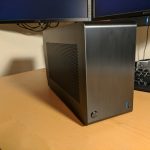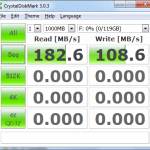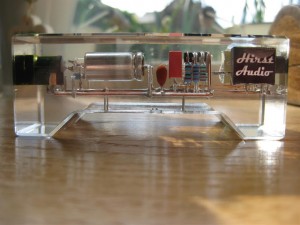That New Computer Smell
http://pcpartpicker.com/b/sjyXsY
This build was based on the Dan-Cases A4-SFX mITX case that started it’s life in the [H]ard|OCP forums and evolved into a Kickstarter campaign. The purpose of this build was make a living room computer / custom Steam box but is currently being used as my main PC until I get my 2011v3 build completed.
The GA-Z170N-Gaming 5 motherboard was purchased during Amazon Prime Day at a steep discount and had several months of use in another case stress testing before I put it into it’s home in the Dan-Cases A4-SFX case.
32 GB of RAM was selected to provide plenty of headroom when using creative applications like Premiere and Photoshop.
This build originally stated with a GTX980 but evolved into the GTX1080 because of the long wait for the case’s Kickstarter campaign.
The 950 Pro NVMe SSD was purchased during a coupon campaign from jet.com – I originally wanted to keep the machine fully SSD but the price of a 2TB NVMe SSD was cost-prohibitive.
Due to the low profile requirements to jam a HSF into the case, I selected the Cryorig C7 cooler. However, there was excessive fan noise from this cooler – particularly when overclocked
The processor was then delidded with a Rockit Cool delidding tool and the thermal compound was replaced with Coollaboratory’s Liquid Pro interface material. This was able to provide over a 30 degree drop in temperatures and allowed me to keep the fan speed very low to keep noise down.
Making Nixie Tubes By Hand
Enabling SLI on non-nVidia supported platforms
Enabling SLI on non-nVidia approved platforms has less of a pain-in-the-ass since nVidia allowed SLI on Intel chipsets, but enabling SLI on a workstation designed to take Quadro cards so it will work with Geforce cards is a little more of a pain in the ass.
In my configuration, I’m trying to enable SLI on an older Dell Precision 690 workstation with an SLI riser card. Normally, nVidia and Dell only allow with very expensive Quadro video cards in this configuration. However, I got myself a pair of GTX260 Core 216 video cards for very cheap and so I wanted to do a little experimenting to get this to work.
Plenty of modifications exist to enable SLI on non-supported configurations, and the solution I chose was DifferentSLI. However, this software patches the nVidia kernel-mode driver and then signs it with a self-signed certificate that obviously isn’t chained to Microsoft’s CA. This means for Windows to load, it has to be put into Test Mode to allow the kernel to accept a self-signed certificate and load the driver.
Since I already had Class 2 validation with StartCom, I embarked on a poorly-documented journey to sign the modified driver file with my Code Signing Certificate from StartSSL and load it, so I wouldn’t have to put Windows into that ever-annoying Test Mode.
Read the write-up here:
http://andrewpeng.net/computing/enabling-sli-on-a-dell-precision-690-with-geforce-video-cards
Dodge Challenger SRT Hellcat at Supercar Saturday
Texas Front License Plate Laws
Let me preface this with the fact that I am not a lawyer, nor should anything in this post be taken as legal advice. Use the information provided here at your own risk.
In researching the front license plate law I found a lot of conflicting information on the requirements of how and where the front license plate can be put on a car that is registered in Texas. I spent a few minutes digging around the Internet looking at credible sources of information (such as published Texas laws and statues from the Texas state legislature.
On USB Flash Drives
Bought another USB flash drive the other day, and suddenly it clicked in my head that I purchased a storage device that was $40, reads and write at well over 100mbyte/sec, and holds 128gbytes, in the palm of my hand.
Benchmarked my old and new drive. Technology has come a long way since 1.44mbyte floppy disks.
Kingston DataTraveler Ultimate 32GB
Sequential read, 1 file, 1024MB: 126MB/sec
Sequential write, 1 file, 1024MB: 82MB/sec
PNY Turbo 128GB
Sequential read, 1 file, 1024MB: 183MB/sec
Sequential write, 1 file, 1024MB: 109MB/sec
Spashdown
Liftoff
Headphone Amp Set in Clear Acrylic
I need to get a headphone amp for my Sennheiser HD280 Pros – maybe this will be my next project. A headphone amplifier assembled “dead bug” style, then set in clear acrylic. Yes. I want one.
Electronic engineers have been encapsulating or potting electronics in resin’s for decades usually for vibration dampening or moisture control its just I decided to make it look presentable 🙂
Source: Rupert Hirst / Runaway Brainz











